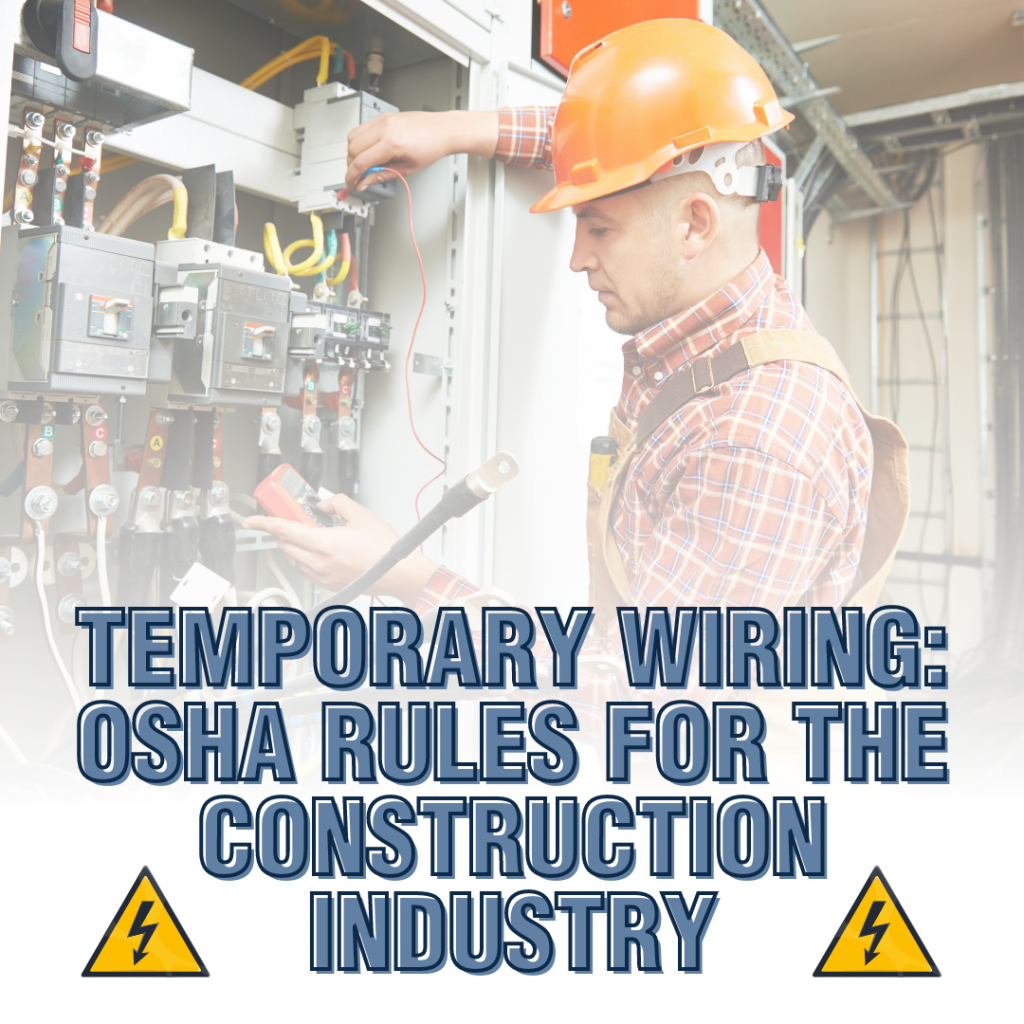We use cookies to make your experience better. To comply with the new e-Privacy directive, we need to ask for your consent to set the cookies. Learn more.
Temporary Wiring: OSHA Rules for the Construction Industry
Electric hand tools. Lights. Building information modeling (BIM) systems. You need them all for a construction job, and they all require power — electrical power in spaces that may not yet have permanent wiring in place.

Temporary wiring is the solution. Most construction sites depend on some form of temporary wiring, to be removed on completion of the job. Building managers in the U.S. must ensure that these wiring systems comply with rules set forth by the Occupational Safety and Health Administration (OSHA) or an OSHA-approved state agency. But OSHA standards are written in a dense legalese that’s not always easy to interpret.
Here are a few frequently asked questions about temporary wiring according to OSHA, along with quick answers that can help you remain compliant.
Do OSHA rules on temporary wiring include extension cables for powering tools and lighting?
The short answer is yes, although it’s a bit more complicated than that. The OSHA standard dedicated to “wiring methods, components, and equipment for general use” in the construction industry is number 1926.405.
Within this standard, “temporary wiring” is covered in section 1926.405(a)(2). Standard 1926 (a)(2)(ii)(J) refers to extension cables specifically: The ones you use for electric tools and equipment must be three-wire. Extension cables used for both tools and lights must be rated for hard or extra-hard usage according to the National Electrical Code, or NEC, or, more properly, NFPA 70—specifically in Article 400, Table 400.4: Flexible Cords and Flexible Cables. Get free access here.
Standard 1926.405(a)2(ii)(H) specifies that it’s okay to run extension cords through doorways and “pinch points,” but only if they’re protected from damage — which the standard says they must be in all cases, anyway.
But “flexible cords and cables” — the legal term including the sorts of extension cables we use to power temporary lights and power tools — are also covered in a separate part of the same standard: 1926.405(g). Builders must comply with all OSHA standards, both those listed under “temporary wiring” and those under “flexible cords and cables.”
What’s the voltage limit listed in OSHA temporary wiring standards?
Standard 1926.405(a)(2) doesn’t provide a hard limit for voltage in temporary wiring. However, it does provide certain restrictions on wiring over 600 volts. According to standard 1926.405(a)(2)(iii), wiring systems over 600 volts must include adequate guarding to prevent access to anyone but “authorized and qualified personnel.” That means some sort of fencing or physical barrier surrounding the wiring.
How long can temporary wiring remain in place at a construction site—and still be considered “temporary” according to OSHA?
You might have heard about a 90-day limit on temporary wiring installations. That actually comes from the OSHA standards for general industry, not for construction. This general-industry standard — 1910.305(a)(2)(i)(B) places that 90-day time limit only on temporary wiring for “Christmas decorative lighting, carnivals, and similar purposes.” So it doesn’t apply to construction work.
In fact, the OSHA standard dedicated to temporary wiring in the construction industry doesn’t specify a time limit on these temporary installations. However, OSHA electrical rules usually correspond with the NEC, which does give us some hard rules about just how “temporary” temporary wiring has to be at a construction site.
In Article 590, section 590.3, the NEC addresses time constraints on temporary wiring. And according to this authority, builders can leave temporary wiring in place for as long as it takes to complete the construction project — but no longer. It allows temporary wiring “during the period of construction,” and specifies that the system should be removed “immediately” after the job is done.
Are there any special rules about powering lights with temporary wiring systems at a construction site?
Lighting is one of the major power requirements at any building site, and OSHA standard 1926.405(a)(2) mentions lights and lamps in a few places. Construction electricians should be aware of (at least) the following rules:
- If you have to place lights in areas that might get wet — or other conductive environments, like inside metal rooms or tanks — those lights should be limited to 12 volts. If you use a ground-fault circuit interrupter, you can upgrade to 120-volt lighting.
- Don’t hang temporary lights by their cords, unless both the lighting equipment and the cord are built for the task.
- If you must use metal-shell sockets, they have to be grounded.
- All lights must be protected, somehow, from breaking and from making contact with workers. That could be a question of placement, guarding over bulbs, or other protective mechanisms; it just has to get done.
How do I learn more about OSHA temporary wiring standards for construction sites?
This FAQ is just an introduction to the topic, and the above answers are far from complete. There’s always more to learn. The ultimate authority is OSHA standard 1926.405, section (a)(2), but you can also find helpful resources on OSHA’s Safety and Health Topics page for electrical work in the construction industry. When in doubt, reach out to OSHA itself for answers; you can find your local OSHA office here.
If you’re looking for electrical material handling equipment to help make temporary (and permanent) wiring jobs safer and more efficient, contact BHS at 1.800.BHS.9500, or email us at sales@bhs1.com.
